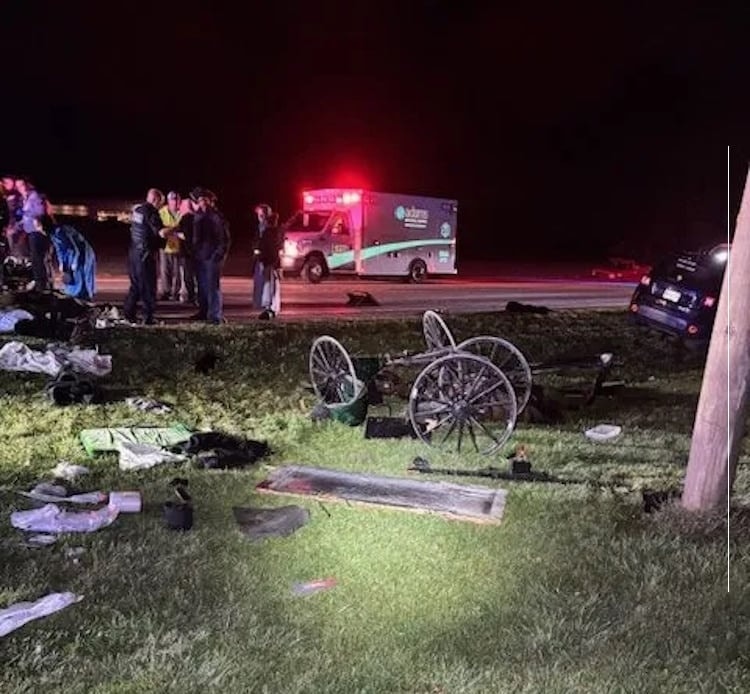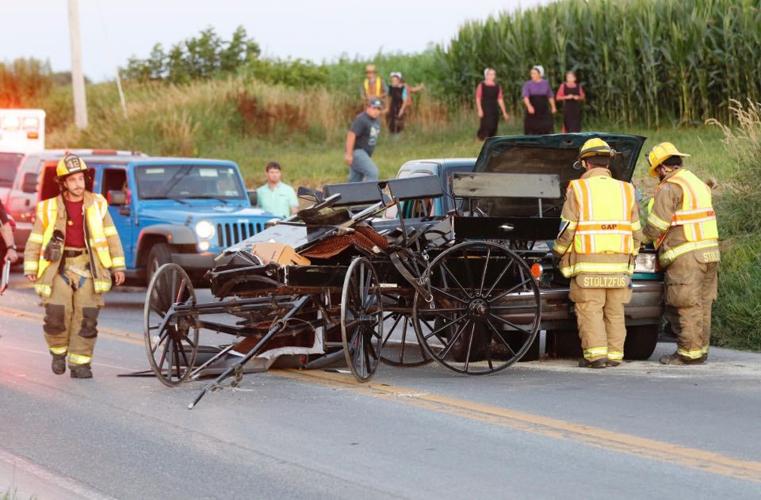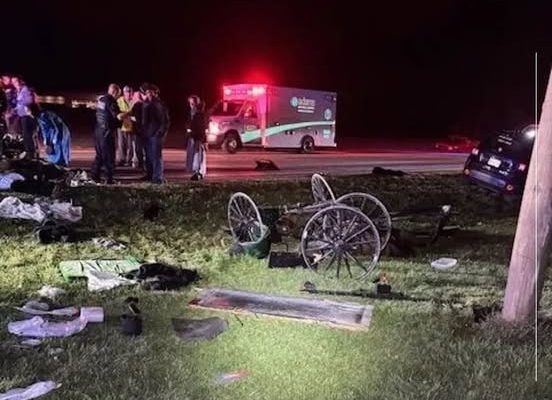
A quiet night in rural Indiana turned unexpectedly tragic when a Jeep collided with a horse-drawn Amish buggy near Berne, leaving several members of a local family injured. What began as an ordinary evening ride became a moment of chaos and concern that united an entire community in compassion and support. The accident occurred on State Road 218 around 11:20 p.m. on October 7, according to officials. When first responders arrived, they found the buggy heavily damaged and debris scattered along the road. A nearby Jeep had veered into a ditch, marking the site of what would soon become a large-scale emergency response involving multiple agencies.
Authorities confirmed that nine people had been traveling in the buggy at the time of the crash. Among them were adults and several children, all part of a local Amish family from the Berne area. The impact sent multiple passengers out of the buggy, prompting an urgent call for medical assistance. Emergency personnel worked swiftly to assess injuries, stabilize the wounded, and coordinate transport to nearby hospitals.
The Rescue and Response

Officials reported that seven individuals from the buggy required hospital care. Ruben L. M. Schwartz, 32, identified as the buggy’s driver, was airlifted to Lutheran Hospital for treatment. Joseph L. M. Schwartz, 20, and five juvenile passengers were transported by ambulance to Parkview Hospital in Fort Wayne. Two other passengers, Saraetta L. Schwartz, 32, and a two-year-old child, declined medical treatment at the scene after evaluation by emergency teams. The driver of the Jeep, identified as 33-year-old Bradley J. Ocilka of Burlington, Kentucky, was also taken for a legal blood draw as part of the investigation but declined additional medical care. As of the latest reports, no formal charges had been filed, and the Adams County Sheriff’s Office confirmed that the investigation remains ongoing.
Responding agencies included Adams County EMS, the Berne and Geneva Police Departments, the Berne Fire Department, Wells and Jay County EMS, Indiana State Police, and Lutheran Hospital’s Flight Team. Their combined efforts ensured rapid medical attention and the safe management of the scene. Officials described the atmosphere as highly organized yet intense, as responders worked late into the night under emergency lights on the dark rural highway.
A Tight-Knit Community in Shock

The Berne region is home to one of Indiana’s largest Swiss-Amish communities, known for its peaceful lifestyle and strong emphasis on family, faith, and neighborly care. News of the crash spread quickly among residents, and by morning, many families had already begun offering help to the affected household. In small Amish settlements like this, events of such magnitude have far-reaching emotional effects. Neighbors often step in to provide meals, transport, and comfort as part of their shared belief in mutual aid and community healing.
Local leaders described the collision as a reminder of the ongoing challenges Amish families face while traveling on modern roads. Unlike motorized vehicles, horse-drawn buggies move at much slower speeds and depend on visibility measures like lanterns and reflective markings to stay safe during nighttime travel. Even with precautions, rural highways can pose serious risks due to limited lighting, narrow shoulders, and the speed difference between vehicles.
The Dangers of Rural Night Driving

Authorities and safety experts have long highlighted the vulnerability of horse-drawn buggies on public roads. Rural areas across Indiana, Ohio, and Pennsylvania—home to large Amish populations—have witnessed similar incidents over the years, often caused by reduced visibility or momentary driver distraction. On dark country roads, even a few seconds of inattention can lead to serious consequences.
Following the crash, the Adams County Sheriff’s Office reiterated its message for all motorists to remain alert and patient when encountering slow-moving vehicles. Drivers are urged to reduce speed, use low beams, and wait until it is safe to pass, especially at night. Rural safety campaigns frequently remind drivers that horse-drawn buggies are a legal and longstanding part of the road community. Reflective triangles, flashing lanterns, and tail lights are designed to make them visible, but the responsibility for safety is shared among everyone using the road.
Traffic safety officials note that speed and visibility are the two biggest factors in such incidents. On unlit roads, a dark buggy may only become visible when a vehicle’s headlights illuminate it—often leaving drivers with just seconds to react. The Indiana Department of Transportation continues to promote educational initiatives about rural driving awareness, particularly in counties with significant Amish populations.
The Human Side of the Story

Beyond the facts and figures, the story of this collision is ultimately about people—a family caught in an unexpected tragedy and a community that refuses to let them face it alone. As news spread, nearby churches, Amish neighbors, and even non-Amish residents began discussing ways to help. Donations of food, transport assistance, and emotional support started flowing in. Though details about the family’s recovery remain private, those close to the community confirm that they are receiving ongoing care and assistance.
Local residents have described the Amish family as hardworking, kind, and deeply respected in the area. “They’re part of what makes this town special,” one resident shared. “Everyone knows someone connected to them. We just want to help however we can.”
The sense of unity that has emerged in the wake of the accident reflects one of the strongest aspects of small-town life: when hardship strikes, people rally together. The shared belief in compassion and service transcends cultural and religious boundaries, creating a powerful network of support.
Lessons for Road Safety and Awareness
This incident serves as a sobering reminder of the delicate balance between traditional lifestyles and modern infrastructure. The Amish community continues to rely on horse-drawn transportation as part of its faith and heritage. However, with the growth of traffic and the speed of modern vehicles, the need for mutual awareness has become more pressing than ever.
Officials encourage both Amish and non-Amish residents to take part in local safety discussions. Workshops and outreach programs are being planned to educate drivers about rural road etiquette, including recognizing buggy signs, maintaining safe distances, and avoiding distractions such as mobile phone use while driving.
Law enforcement also highlights the importance of community education. Many rural counties have started installing additional signage indicating areas where buggies frequently travel. Some local governments are exploring infrastructure solutions such as wider shoulders and reflective barriers to make nighttime travel safer for both drivers and the Amish community.
Investigations and Next Steps

As of now, authorities have not released further updates on whether charges will be filed in connection with the collision. Investigators are reviewing witness statements, vehicle data, and road conditions to determine what factors contributed to the crash. The Adams County Sheriff’s Office, in collaboration with the Indiana State Police, continues to collect evidence and evaluate safety recommendations based on the findings.
The investigation’s outcome will likely shape future road safety discussions in the county. Officials emphasize that their goal is not only accountability but also prevention—understanding how to avoid similar accidents in the future. The focus remains on recovery, safety, and healing, both for the family involved and the wider community affected by the event.
Hope and Healing in Berne
For those who witnessed the aftermath or took part in the emergency response, the night will be remembered for its mix of heartbreak and heroism. Paramedics, firefighters, and volunteers worked side by side under flashing lights, driven by one goal: to ensure that every person received care as quickly as possible. That teamwork embodies the values that define small communities like Berne—resilience, empathy, and the instinct to help.
In the days that followed, local residents organized quiet gatherings and prayer meetings for the family’s recovery. Amish families often prefer privacy during times of hardship, but the outpouring of concern from the broader community has been deeply felt. Churches, civic groups, and local officials are now coordinating efforts to raise funds for medical expenses and to support the family as they rebuild after the incident.
Residents have also taken the opportunity to reflect on broader lessons from the event. Discussions on social media and community forums have centered on how modern drivers can better coexist with traditional road users. The consensus is clear: greater patience, understanding, and awareness can prevent future tragedies.
Moving Forward Together
What happened on State Road 218 is a stark reminder that even a few moments can change lives—but it is also a story about strength, faith, and community. The Amish family affected by the crash faces a long recovery, yet they are surrounded by people determined to help. The town of Berne has turned its collective concern into action, embodying the very spirit that defines rural Indiana.
For travelers across the state, this story serves as both a caution and an inspiration. It highlights the importance of safe driving, particularly in areas where traditional horse-drawn transportation remains part of daily life. It also reminds us of the humanity that connects us all, regardless of background or belief.
As the investigation continues, authorities ask the public to keep the family in their thoughts while respecting their privacy. The road ahead may be difficult, but for those involved, the love and support of their community offer a guiding light through recovery and renewal.
Sources:



